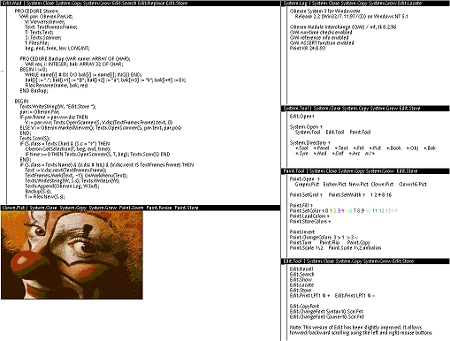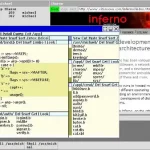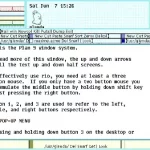Last Updated on: 20th July 2023, 12:54 pm
Web site: www.ethoberon.ethz.ch
Origin: Switzerland
Category: Desktop
Desktop environment: TUI (text user interface)
Architecture: x86, Ceres, Xilinx Spartan, SPARC, PowerPC, RIOS, MIPS
Based on: Independent
Wikipedia: Oberon
Media: Install
The last version | Released: V5 | 2013 (?)
Oberon – a single-user, multi-tasking system that runs on bare hardware or on top of a host operating system. Oberon is also the name of a programming language in the Pascal/Modula tradition.
The Oberon project was started at the Swiss Federal Institute of Technology in Zürich (ETHZ) in 1985 by Niklaus Wirth and Jürg Gutknecht. Although the project was originally targeted towards in-house hardware, the language and system have now been ported to many computer platforms. Oberon is also a name of a modern integrated software environment.
In 1991, Jürg Gutknecht and his group continued the development towards the ETH Oberon System. The goal was to exploit the inherent potential and features of Oberon to a much larger degree, upgrade the system by a concept of composable and persistent objects, complement the textual user interface by a graphical companion and provide support for the ubiquitous network. In 1995, the first official Oberon System 3 release was finished. Since then, the system has been constantly improved and extended. In 1997, the Release 2.2 including a large palette of applications was published together with a comprehensive hypertext-based documentation. In March 2000, a new release was ready and the system was renamed “ETH Oberon System”.
The original Oberon system is a single-threaded, single-user, co-operative multi-tasking operating system that runs on bare hardware or on top of a hosted operating system as a single-window application. The ETH Oberon System is an extended version that has intrinsic support for persistent objects and for building graphical user interfaces. It presents itself as a hierarchy of modules, many of which export one or several powerful abstract data types. Application modules simply reuse these data types and do not have to care about their implementation at all.
ETH Oberon System highlights:
– Advanced Textual User Interface
– Integrated object support in the kernel
– Object Autonomy and Persistence
– Extensibility by Software Bus Technology
– Fully Hierarchical Composability
– Generalized MVC Scheme
– Powerful GUI Framework Gadgets
– Self-Contained Documents
– Extensibility on Different Levels
The ETH Oberon System package includes several interesting tools and applications. Many of them were developed as productivity tools by ETH assistants and students.
The Oberon system is available free of charge and no registration is required for downloading the material. The source code is available under a BSD-like License.
The source of the Oberon screenshot is Wikipedia; uploader: SomPost; under BSDU License.





Hello! Do you use Twitter? I’d like to follow you if that would be ok.
I’m definitely enjoying your blog and look forward to new
posts.